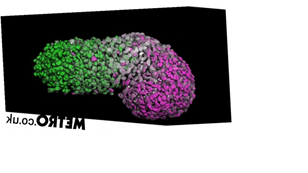A new ’embryo-like’ model developed in the lab using stem cells has allowed scientists to observe the earliest stages of human development for the first time.
Researchers from the University of Cambridge and the Hubrecht Institute in The Netherlands, who created the model, said their new system mimics certain key features of a 20-day-old human embryo but does not have the potential to develop into a fully-formed embryo.
They believe their work could help shed light on the causes of birth defects and other medical issues such as infertility and miscarriage.
Until now, this type of human embryonic development has not been directly observed due to ethical restrictions on use of human embryos in research.
This is because research on human embryos, which can only happen under a licence in the UK, has a 14-day cut off point and it is currently illegal to keep them alive in a lab setting for more than two weeks after fertilisation.
The researchers said their embryo-like model, which is just 72 hours old, does not have brain cells or any of the tissues needed for implantation in the womb and, thus, conforms to current ethical standards.
The study, published in the journal Nature, was reviewed and approved by the ethics committee of the University of Cambridge.
Dr Naomi Moris, in the University of Cambridge’s department of genetics, and first author of the report, said: ‘This is a hugely exciting new model system, which will allow us to reveal and probe the processes of early human embryonic development in the lab for the first time.
‘Our system is a first step towards modelling the emergence of the human body plan, and could prove useful for studying what happens when things go wrong, such as in birth defects.’
During early developmental stages when the human embryo is just a group of cells, it folds in on itself to form a three-layered structure, a process known as gastrulation.
These layers later go on to form different tissue types present in the human body.
The process of gastrulation usually begins around 14 days after fertilisation, hence scientists have been unable to observe the mechanisms of this process.
Birth defects are thought to originate during this crucial period of development.
The researchers observed the genes that were expressed in their three-day-old ‘gastruloid’ model.
They found ‘a clear signature’ of the processes that give rise to important human body parts such as thoracic muscles, bone and cartilage.
While similar animals models have been developed before, the researchers said certain drugs that work on animals models may not be useful for humans.
For example, they said, the anti-morning sickness drug thalidomide passed clinical trials after tests in mice but caused severe birth defects in humans.
For this reason it is important to develop better models of human development, the researchers added.
Commenting on the research, Professor Robin Lovell-Badge, a senior group leader and head of the Laboratory of Stem Cell Biology and Developmental Genetics at the Francis Crick Institute, said that while a robust model of ‘this rather mysterious period of human embryo development’ is needed to understand why things so wrong, the researchers’ gastruloid model needs to be validated, which may require obtaining embryos that are surplus to IVF treatment and ‘cannot be done in the UK and many other countries for legal reasons, as it would cross the 14-day limit’.
Prof Lovell-Badge said: ‘If the law were changed, however, even a few such cultured embryos might suffice to validate the model.
‘Until then, there will always be doubt about this or other models of human development during this critical, but hidden period.’
Source: Read Full Article

